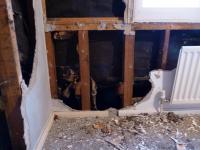Do a bit of gogling for " timber frame construction " and see the arrangement of the timber frame, insulation and the necessity for a vapour barrier
The vertical timbers are studs as in a " timber stud wall "
The crucial things to bear in mind are that you don't want any air pockets against the cold external wall or generally within the wall (condensation risk) and you want to prevent moist air from the room permeating into the timber frame (use of a vapour barrier or vapour check"
The vertical timbers are studs as in a " timber stud wall "
The crucial things to bear in mind are that you don't want any air pockets against the cold external wall or generally within the wall (condensation risk) and you want to prevent moist air from the room permeating into the timber frame (use of a vapour barrier or vapour check"



